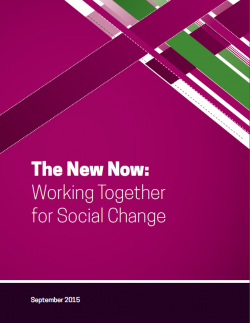Sep
24
2015

Written by Sean Thomas-Breitfeld
Frances wrote earlier this year about our struggles to tease out “intersectionality” the buzzword from intersectionality as an analytic approach that moves beyond single-issue organizing and advocacy. The release of our latest report The New Now is based on interviews with organizers and activists in New Mexico and Ohio who are bringing an intersectional approach to their work in the LGBT movement. So, it seemed like a good time to revisit the concept, especially as the word’s popularity continues to grow.
Intersectionality challenges the tendency to separate problems out on the basis of factors like race, gender, sexuality or class. Instead, the concept pushes us to examine the ways that social and policy issues are simultaneously about multiple systems of oppression. It is especially helpful for understanding how a challenge like employment discrimination is made worse for people – such as black women – who face bias based on their gender and their race. Intersectionality is a powerful concept for explaining the lived experience of people who are too often ignored by single-issue organizing.
Despite its academic origins, intersectionality is making it into everyday discussions. A quick search on Google Trends shows that intersectionality didn’t even rank as a search term until 2007, almost two decades after Kimberlé Crenshaw originally coined the term in 1989. The word is now so ubiquitous that the Washington Post chose intersectionality as the next big idea “percolating just outside the mainstream” to debate and explore as part of its new “in theory” blog.
I have to admit that I often interpret comments (especially by white activists) on intersectionality to fall into an “intersectionality-lite” category. They frequently (mis)use the word when making the obvious point that issues and constituencies are connected, and mutual support between organizations and communities makes our movements stronger. That’s a fine starting point, but it seems to fall short. Intersectionality isn’t just about making connections between struggles; it is also about putting the experiences of people with multiple marginalized identities at the center of our analysis and strategizing. Brittney Cooper’s piece for the “in theory” blog describes how a “more mature and evolved notion of intersectionality” is emerging as trans and gender nonconforming people push for full inclusion and support within the Black Lives Matter movement. And the stories we gathered from New Mexico and Ohio reflect a similar evolution.
To write The New Now: Working Together for Social Change, Frances and I talked to people working to take intersectionality beyond the realm of theory and apply it to their grassroots organizing, alliance and coalition building, and their policy change work. And it was the queer women of color we interviewed who were often so central to making an intersectional approach a reality in both states. If we’re going to make the focus on intersectionality last, we need more people to use and understand the concept, and we also need people for whom intersectionality is deeply felt in their lived experience to have the voice and power to chart the course for our movements.
